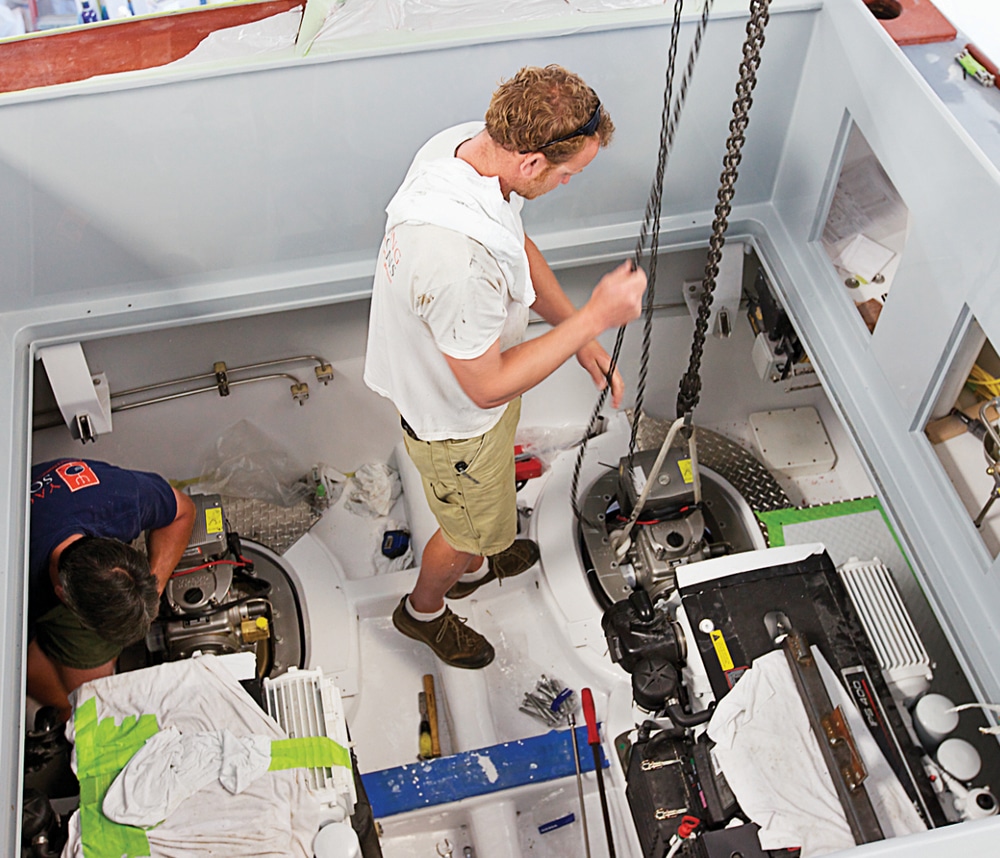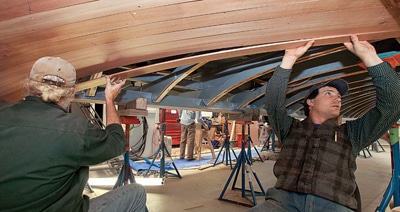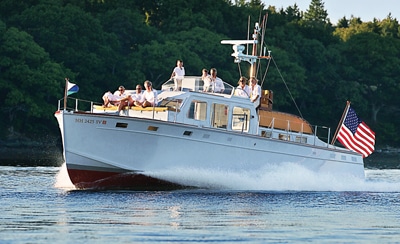
Resto-Mod Repowering With Volvo IPS
Yachtsmen have several ways to satisfy their desire for a classic yacht: 1) buy an old one and have it restored to original specification; 2) buy an old yacht that someone else has restored to original; 3) buy an old boat and do a resto-mod (retaining the original look but installing modern power and systems); or 4) have a custom yacht designed in the classical theme and built with modern materials and systems. Sam Rowse and Martha Coolidge have experience with numbers 1, 3 and 4 — a 1932 6-Meter designed by Sparkman & Stephens, a 1954 Huckins Offshore 46 and Anna, a 56-foot cruising/racing sloop designed by S&S, built of cold-molded wood at Maine’s Brooklin Boat Yard and launched a few years ago.
Their Huckins 46, which Rowse and Coolidge christened Northern Spy, captivated the couple during the handful of years that her previous owner cruised the waters off Rockland, Maine. He had bought her in Florida in 2005, taken her to the Huckins yard for restoration and hired Bill Morong, owner of Yachting Solutions in Rockport, Maine, to manage the project. When the owner decided in 2008 to sell the boat, she wound up on the hard, again under Morong’s care, and that’s where Rowse found her. “I think I want to buy that boat,” Rowse said to Morong. They had a deal worked out within a week. Score one for the emotional side of boating.
Rowse had been interested in pod-drives for some time and decided that if the Huckins would graciously accept this modern intrusion, restoring and updating her — a resto-mod — would cost considerably less than a truly custom build. He could also be using the boat in less than a year (eight months, in this case) from the time Yachting Solutions began the project, instead of the two or three years that a custom design and build would take.
In addition to the visceral appeal of this Huckins, she turned out to be an ideal subject for repowering with modern, electronically managed diesels and azimuth thruster, or pod, drives. “This boat lent itself particularly well,” Morong said, “because the engine room is way back aft.” If the engine room had been amidships, Yachting Solutions would have needed to run jack shafts from the engines to the pods, a distance of about 25 feet. “It complicates things a little bit because you have to hide the shafts,” Morong said, and that would have compromised the accommodations and added expense to the project.
Rowse and Morong looked at the Zeus drives from Cummins MerCruiser Diesel but discovered that the company wasn’t yet ready to deal with retrofits. Volvo was, and what’s more, the company was excited about installing IPS on a hull of such shallow deadrise (approximately 5 to 7 degrees at the transom) and felt certain that bonding the fiberglass pan, or grid system, to the existing glass-encapsulated wooden hull would be straightforward.
Paul Waring, of Stephens, Waring & White Yacht Design in Brooklin, Maine, performed a weight study and helped to determine if the Huckins could handle the power/drive transplant. The Volvo Penta IPS 400s (300-horsepower four-cylinder diesels) weigh approximately 900 pounds more than the four-cylinder Cummins V-drive power package that the previous owner had installed in 2005. The Cummins engines gave the Huckins a top speed of 21 knots and a cruising speed of 15 to 16 knots. Volvo predicted a top speed of 30 knots and a cruising speed of 25. These higher speeds would create an exponential increase in stress on the bottom. Yachting Solutions also discovered that the keel bolts had drifted upward and that the bottom had gone flat — lost its concavity — so the team decided to replace the entire bottom and laminate a new oak keel and stem.

Stripping the bottom planking exposed the yacht’s vascular and nervous systems and allowed the team to upgrade the plumbing and wiring and to install central heat and air conditioning, a scuba compressor, a 1,400 gpd watermaker and a Genasun (www.genasun.com) lithium-iron phosphate battery pack — all without dismantling the interior. These batteries have a very stable chemistry, so they won’t catch fire, as lithium-ion batteries sometimes do; they are 50 percent lighter than lead-acid batteries of the same power; and their footprint is about half the size of four 8-D lead-acid batteries for the same total of 370 ampere-hours. Each pair of cells has a processor and monitor, and all of the cells are individually replaceable.
By far, the most important element of this project was preparing the engine room to receive the new power package. The drives and engines sit on a robust fiberglass grid, 17 layers thick on the bottom and reinforced with foamcore fiberglass stringers. The laminate continues up the sides of the hull for at least a foot, becoming thinner as it approaches its terminus. This tapering, or feathering, of the exposed joint between the hull and grid helps create a secure bond between the two. Volvo has designed and engineered the grid to withstand the routine stresses of propelling and steering the boat, and to let the drives sheer off, without damaging the hull, when they meet an immovable object in the water. Rocks and deadheads come to mind.

After Yachting Solutions finished the project, the engine room looked as though the Huckins had just emerged from the factory. Appearance is one thing, but vice-free handling, speed and fuel economy determine the success of such a transplant. I spent a day aboard Northern Spy in the company of the owners and Morong. We cruised from Rockland to Northeast Harbor and back, and I’m happy to report that Frank Pembroke Huckins could have designed the Fairform Flyer hull, way back when, with IPS in mind. Northern Spy was remarkably quiet, especially so at a cruising speed of 20 knots but also at her top speed on the day just shy of the projected 30 knots; she sipped, rather than gulped, fuel; and she handled like the thoroughbred she is. The owners are happy too.
**
Yachting Solutions, 207-236-8100; www.yachtingsolutions.com; www.cmdmarine.com**
Subscribe to the Yachting Life newsletter for cruising and chartering guides, new boat announcements, event updates, special offers and more!








